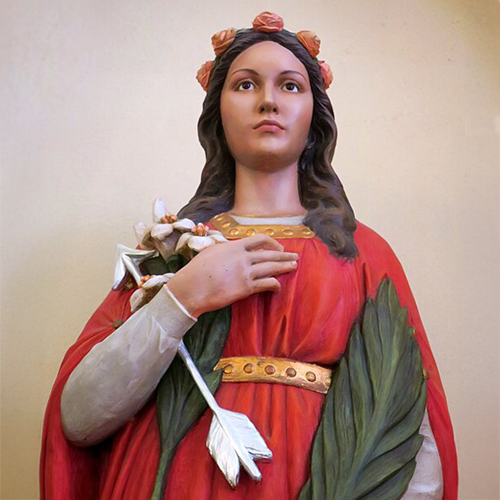
August 11
Saint Philomena is a saint shrouded in mystery. In 1802, the bones of a 13-year-old girl were found in one of the catacombs, or underground burial caves, in Rome. The space was marked by terracotta tiles spelling out, “Peace be with you, Philomena.” The images on the tiles (two anchors, three arrows, a palm branch, and a flower) seemed to be images of martyrdom. The bones were believed to have come from one of the earliest ages of persecution in the Church.
These remains, with the tiles, were sent to the church of Madonna della Grazie in the village of Mugnano del Cardinale, where they remain to this day. Miracles associated with this saint were recorded by the local priest. A nun, Sister Maria Luisa of Jesus, wrote revelations describing the life of Saint Philomena, which was revealed to her in visions. These writings were distributed worldwide. Noted holy people of that time, including Venerable Pauline Marie Jaricot and Saint John Vianney, were healed of illnesses through the intercession of Saint Philomena.
The absence of the word martyr at her burial site cast doubt on the revelations of Sister Maria Luisa. Some historians suggested that the tiles had been reused and that the relics were not Philomena’s relics. Considering these doubts, the Church removed Philomena from its calendar of liturgical worship in the 1960s.
However, devotion to this saint continues. For example, Saint Pio of Pietrelcina (Padre Pio) defended Philomena and her miracles and declared that the name of the saint didn’t really matter, as it wasn’t the name that performed the miracles. Even the Vatican recognizes that this saint has interceded for many faithful and is considered the patroness of newlyweds.
We are not obliged to believe Sister Maria Luisa’s revelations, but the miracles, as Padre Pio pointed out, speak for themselves and attest to the holiness of this mysterious saint who is almost unknown to us, but not unknown to God.
(Image © Nheyob, CC BY 4.0, via Wikimedia Commons)